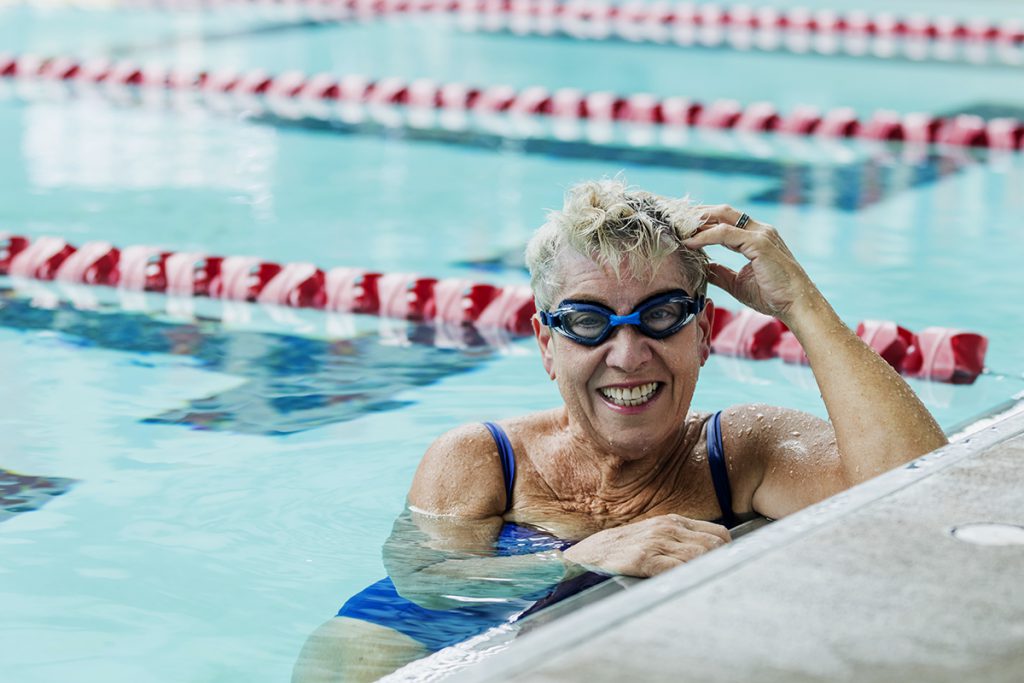6 Pesky Pool Workout Problems, Solved!
We put your toughest questions to the pros, so you can feel confident jumping in.

Swimming is one of the most popular activities in the U.S., but it’s not without its downsides—harsh chemicals, unwieldy swimsuits, germs, and more.
We know you have questions you’d like answered before you jump in the water. Don’t worry, we’ve got you covered: We tapped a handful of swim and health experts for answers to some of your top queries (even the embarrassing ones). Check out these solutions for common pool workout problems.
Ready for a pool workout? Find participating SilverSneakers fitness locations here. Tip: Use the “Filter” tool and click “amenities” to narrow your search to locations with pools.
Question #1: Chlorine Makes My Skin So Dry That It Peels. How Can I Combat the Damage?
As we age, our skin thins out a bit, making it more prone to dryness. Unfortunately, chlorine in swimming pools can make things worse.
“Chlorine and its byproducts can remove oil from the skin, cause contact dermatitis, and worsen preexisting skin conditions, including xerosis, or ‘dry skin,’” says Meghan Feely, M.D., a clinical instructor in the department of dermatology at Mount Sinai in New York City. “It can also leave your nails and hair feeling brittle.”
To keep your skin healthy, rinse off with water and a gentle cleanser as soon as possible after you get out of the water. Formulas made for sensitive skin, such as Cetaphil, contain nourishing ingredients that soothe irritated skin.
Pat skin dry with a soft, cotton towel, and apply moisturizer from head to toe. For best results, look for a moisturizer with ceramides, which are fat molecules that are found in the skin’s barrier, as these can rehydrate your skin and help repair your skin barrier, Dr. Feely says. CeraVe is one option.
Question #2: I’ve Stopped Going to My Water Aerobics Class Because of Urinary Incontinence. Any Ideas for Controlling UI?
“I would say most water exercise coaches understand that if adults are going to be in the water more than 45 minutes, they’ll need to head to the bathroom,” says Sue Nelson, a certified aquatic fitness instructor and co-founder of Total Aquatic Programming in Colorado Springs.
Don’t be embarrassed to exit the pool during class or in between laps to take a bathroom break.
If you typically rely on incontinence pads for protection, save standard pads for dry land, as they will fill with water and could cause waste to leak into the pool. Instead, consider investing in disposable swimwear. Swimmates Disposable Swimwear, for example, are a waterproof underwear-style product for both men and women.
They’re made to be worn subtly under a bathing suit, keeping both you and the pool clean if you have an incident. They’re also easy to remove and dispose of later.
If certain higher-impact water exercises trigger a leak—jumping jacks, for example—ask the instructor to show you how to modify the move or provide an alternative.
Question #3: My Doctor Says Swimming Won’t Help My Bone Strength. Is That True?
Yes and no. Swimming laps may not be the best sport for building bone mass, but it can help stave off normal bone loss that comes with age, according to a 2013 review.
That said, you can make swimming a better bone-building activity by performing resistance exercises in the pool using weights, swim paddles, or even a current, if the pool has that function, says Tamara Jacobs, D.P.T., a physical therapist who specializes in aqua therapy at the Hospital for Special Surgery in New York City.
Compared to doing laps, standing strength exercises done in the pool (think squats, lunges, and walking through the water) will put more weight on your joints—a prerequisite for building bone mass. You can see for yourself by signing up for a SilverSneakers Splash, which is great for all skill levels. It’s offered at participating SilverSneakers fitness locations.
Don’t want to give up your freestyle or backstroke? Consider adding a few strengthening exercises to the end of your lap routine, Jacobs says.
Recommended reading: A 20-Minute Cardio-Interval Workout You Can Do in the Pool (No Laps!)
Question #4: Can the Pool Chemicals Really Handle Germs and Even Pee?
There’s no way to sugarcoat this—swimming with other people also means swimming with contaminants from sweat, cosmetics, urine, saliva, and fecal matter. The biggest concern with pools is the spread of viruses, bacteria, protozoa, and fungi that may make you literally sick to your stomach.
“The most commonly reported illness from these contaminants is diarrhea,” says Matthew Goldman, M.D., a family medicine specialist at the Cleveland Clinic. However, other common health issues from swimming pools that are poorly maintained include swimmer’s ear (an itchy, sometimes painful infection in the outer ear canal), skin rashes, and respiratory infections.
Pool managers have two main ways of keeping pools sanitary: the removal of waste using a dilution system and disinfection to kill infectious microorganisms. Chlorine is one of the most common disinfectants used in swimming pools, and highly effective in the right amounts.
“When the pH and disinfectant levels are correct, chlorine will kill most germs in pools and hot tubs within an hour,” Dr. Goldman says. Other disinfectants like bromine, ozone, and ultraviolet radiation may also be used, either alone or in combination.
If you’re worried about germs, ask the staff about their maintenance routine and recent inspection score. Public pools should drain and replace a portion of the water on a weekly to monthly basis. And the pH and disinfectant levels should be checked at least twice a day, according to the CDC.
You can even buy your own test strips at a pool supply store to check if the water’s pH and bromine or free chlorine levels are correct before dipping your toe in.
It’s also important to do your part to make the pool a healthier place, says Dr. Goldman. Follow these guidelines:
- Shower with soap before and after swimming.
- Wash your hands after using the bathroom.
- Don’t swallow pool water. Keeping your mouth closed is by far the best way to avoid getting sick from pool water, Dr. Goldman says.
- Don’t swim if you have diarrhea. If you have infectious diarrhea, wait at least two weeks after the diarrhea stops.
- Don’t swim if you have an open cut.
- Keep your ears as dry as possible. Wearing ear plugs, custom-fitted swim molds, or a swim cap may help prevent water from entering your ears.
Question #5: Water Workouts Sound Great, But the Pool Feels So Cold. What Gives?
“As we age, our bodies become more sensitive to hot and cold temperatures,” says Jacobs.
In general, you’ll probably feel most comfortable in a pool that’s 86°F to 88°F, but if you have osteoarthritis or muscle tightness, you may perform better in a slightly warmer pool (88°F to 92°F ).
That said, the ideal pool temperature will change with exercise intensity: As intensity increases, preferred temps decrease. If the pool is heated on the higher end of the spectrum, lower your exercise intensity to avoid overheating. And if you have a heart condition, it’s important to monitor your exercise intensity in warmer pool temps, she adds.
Subscribe to our newsletter
It's quick and easy. You could be one of the 13 million people who are eligible.
Already a member? Click to discover our 15,000+ participating locations.
Follow Us
If you’re regularly bothered by a cold pool, the best thing you can do is warm up before you step in the water. Try walking a couple of laps around the pool deck or marching in place while doing some arm circles.
“A proper warmup combined with targeted exercises should allow you to adapt to the temperature,” Jacobs says.
If that doesn’t do the trick, you can try wearing a thin neoprene wetsuit vest, shorts, or cap. The neoprene acts as an insulator. Just make sure your clothes have a snug fit so they’re not floating around while you swim.
Question #6: What’s the Best Way to Protect My Hair from the Pool Chemicals?
“When it comes to swimming, most stylists will have the same recommendations, regardless of age or hair type,” says Cassandra Hoggins, a stylist based in Chicago.
And while people of different races need different hair products and routines, the advice for safeguarding your locks is ultimately the same, Hoggins says.
1. Wet your hair with non-chlorinated water first. “Think of your hair as a sponge,” Hoggins says. “When it’s dry, it’s able to soak up a lot of liquid. Once wet, it needs to release some of that liquid before it’s able to accept any more.”
2. Apply a leave-in conditioner. Similar to the above option, filling your hair with liquid or cream before getting in the pool can help keep chlorine from soaking into your strands.
“The difference here is that the conditioner can double as a protective barrier and moisturizer as well,” Hoggins says. This option is ideal for people who already have dry hair.
3. Wear a swim cap. “While it may not always be the most stylish choice, it is your best bet for keeping the most water off your hair and scalp,” Hoggins says.
4. Shampoo while your hair is still wet. What you don’t want to do is let your hair dry before you’ve had a chance to rinse out the chlorine water. That’s a sure way to invite damage. Allow enough time for a shower after your workout. If possible, let your hair air dry.
5. Use a clarifying shampoo if you use the pool regularly. A clarifying shampoo, such as TriSwim, will help clean your hair post-swim.
Check Your SilverSneakers Eligibility Instantly
SilverSneakers members can go to thousands of gyms and fitness locations across the nation, plus take SilverSneakers LIVE online classes that are designed for seniors of all levels. If you have a Medicare plan, it may include SilverSneakers—at no additional cost. Check your eligibility instantly here.
Not eligible for SilverSneakers? You can still get 200+ free SilverSneakers On-Demand videos and stay in touch with us by creating your online account.




